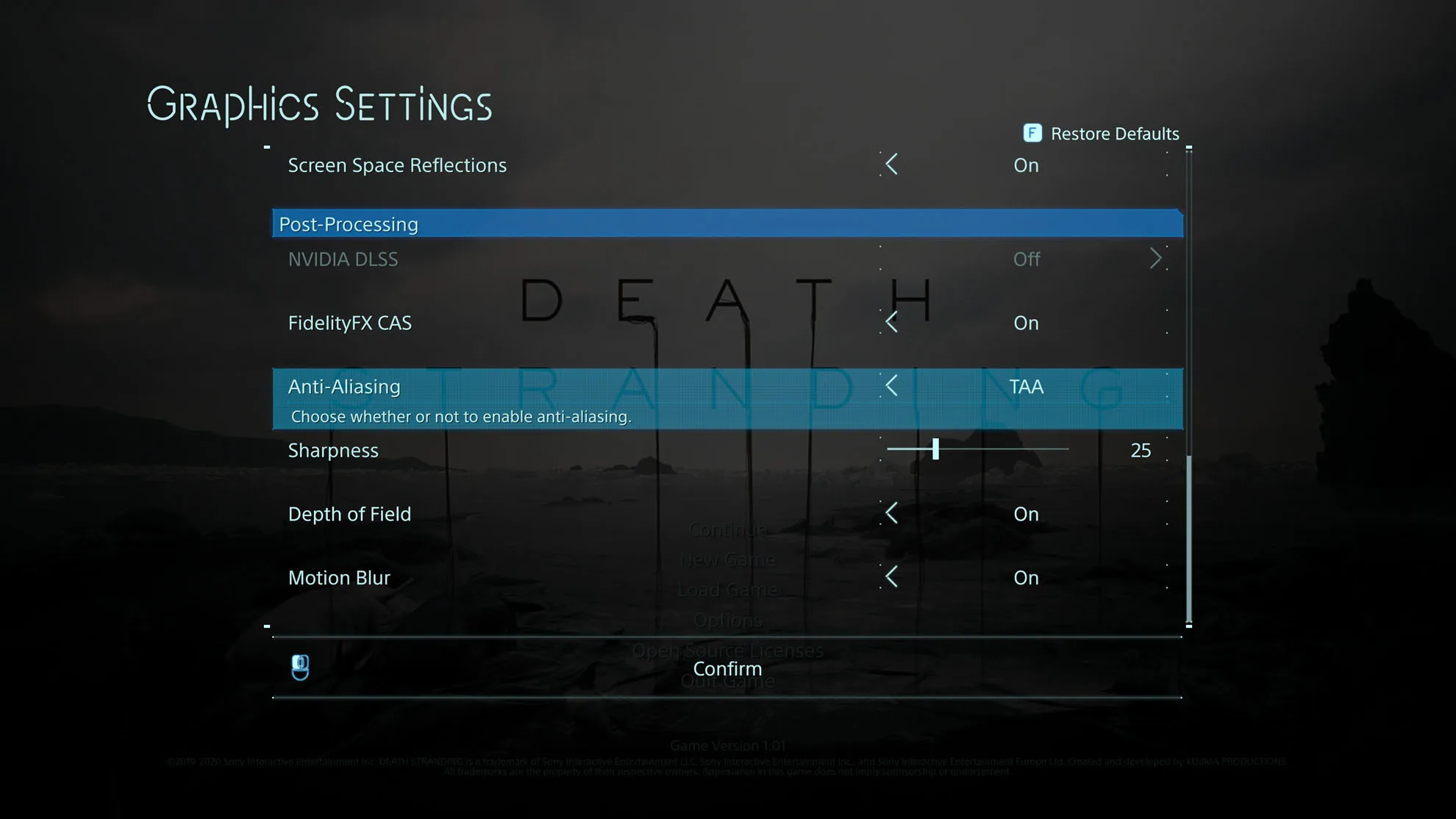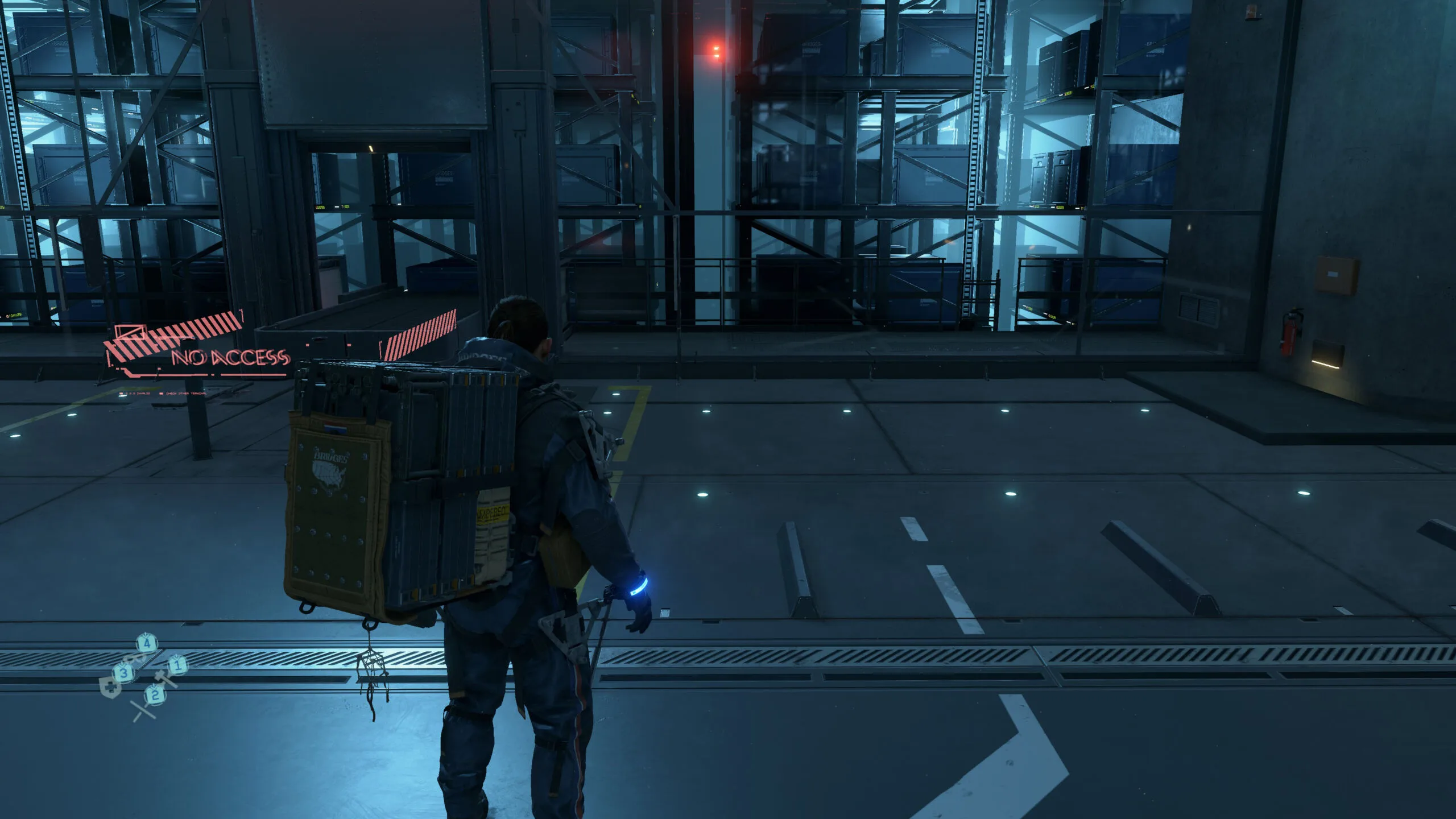The Death Stranding IQ & DLSS 2.0 Performance Review – Updated with v1.01 Benchmarks
Nearly two years ago, NVIDIA introduced realtime RTX ray tracing together with Deep Learning Supersampling (DLSS). To play at high settings and with ray tracing on requires the use of AI super resolution or DLSS which provides better than TAA IQ together with improved performance. Death Stranding doesn’t use ray tracing, but rather uses DLSS 2.0 to improve performance, and we will compare the current performance and IQ (image quality) of all five current NVIDIA RTX cards updated by yesterday’s 5.1GB patch.
BabelTechReviews received a copy of Death Stranding from NVIDIA when it launched earlier this week with high expectations. After all, it is a well-optimized PS4 port to PC from the legendary game developer, Hideo Kojima. It originally received very high praise including some 10/10 (perfect game) awards when it released last year. We played it for hours using a RTX 2080 SUPER but were let down. Instead of a game review, we are going to concentrate on what we consider to be the real jewel of this AAA game – DLSS 2.0’s IQ and performance versus TAA.
We played Death Stranding using our new i9-10900K/RTX 2080 SUPER/32GB DDR-3600 PC for more than a few hours and were somewhat impressed with its visuals as a port from an aging console. The game’s outdoor scene environments aim to be photo-realistic, and it mostly succeeds except for some poor textures in areas and pop-in that can be annoying. The character models are fairly well-detailed, but not approaching the level of Red Dead Redemption 2. 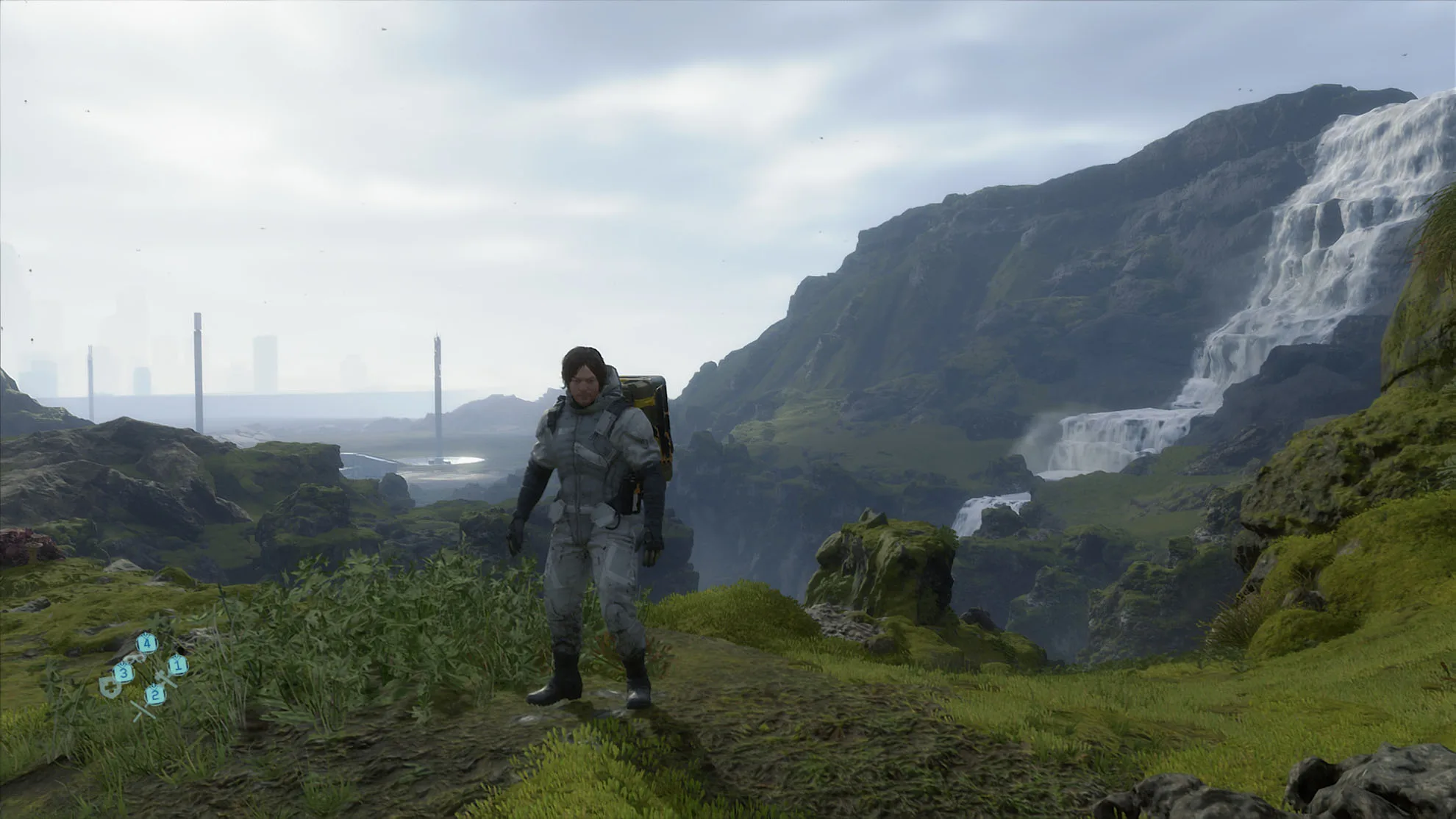
Death Stranding uses cut scenes to tell its apocalyptic story as a 40 to 60 hour long interactive cinematic experience. The voice acting and motion capture by big name stars, the superb audio, and the amazing sound track, are all absolutely top notch as befits a big studio’s AAA efforts. Norman Reedus of ‘The Walking Dead’ fame is Sam Bridges Porter, and he brings his role reconnecting America to life by delivering critical supplies despite lacking any character development options or a skill tree. You can almost feel the weight of the cargo strapped to his back as he curses and mutters under his breath while struggling to maintain balance in rough terrain.
Unfortunately, the story is painfully slow-paced, and it involves weird science fiction with logic gaps that just do not work. You will face a moral quandary with ‘bridge babies’ as you must use one to survive attacks from invisible malevolent creatures. You will deal with exploding necrotic humans that can crater entire cities; and if you die, your own body will explode leaving an impassable crater that you will have to detour around when you return to life as a ‘Repatriate’ to resume your delivery.
Sam is a porter – a human pack animal since there are no longer any roads – who carries goods between outposts. He is the adopted and estranged son of the last U.S. President. Sam is also the brother of now captive Amelia who is leading America’s reconstruction yet she can communicate despite being held by separatists. Although Sam cannot handle being touched, his task is to connect the isolated remaining few civilized outposts into a grid as humanity’s last hope, and the story unfolds through endless cutscenes.
The game’s action is also very slow and it requires doing the same thing over-and-over with painfully slow pacing. For the first few hours, Death Stranding is a walking simulator and you are the delivery boy. To be successful, you must carefully plan out each route by marking waypoints on your map. You must plan on taking rope, anchors, and the right ladders to climb steep hills and to ford swiftly moving steams. It is also critical that you balance and micro-manage your load appropriately to its contents as well as to the journey’s terrain to be successful.
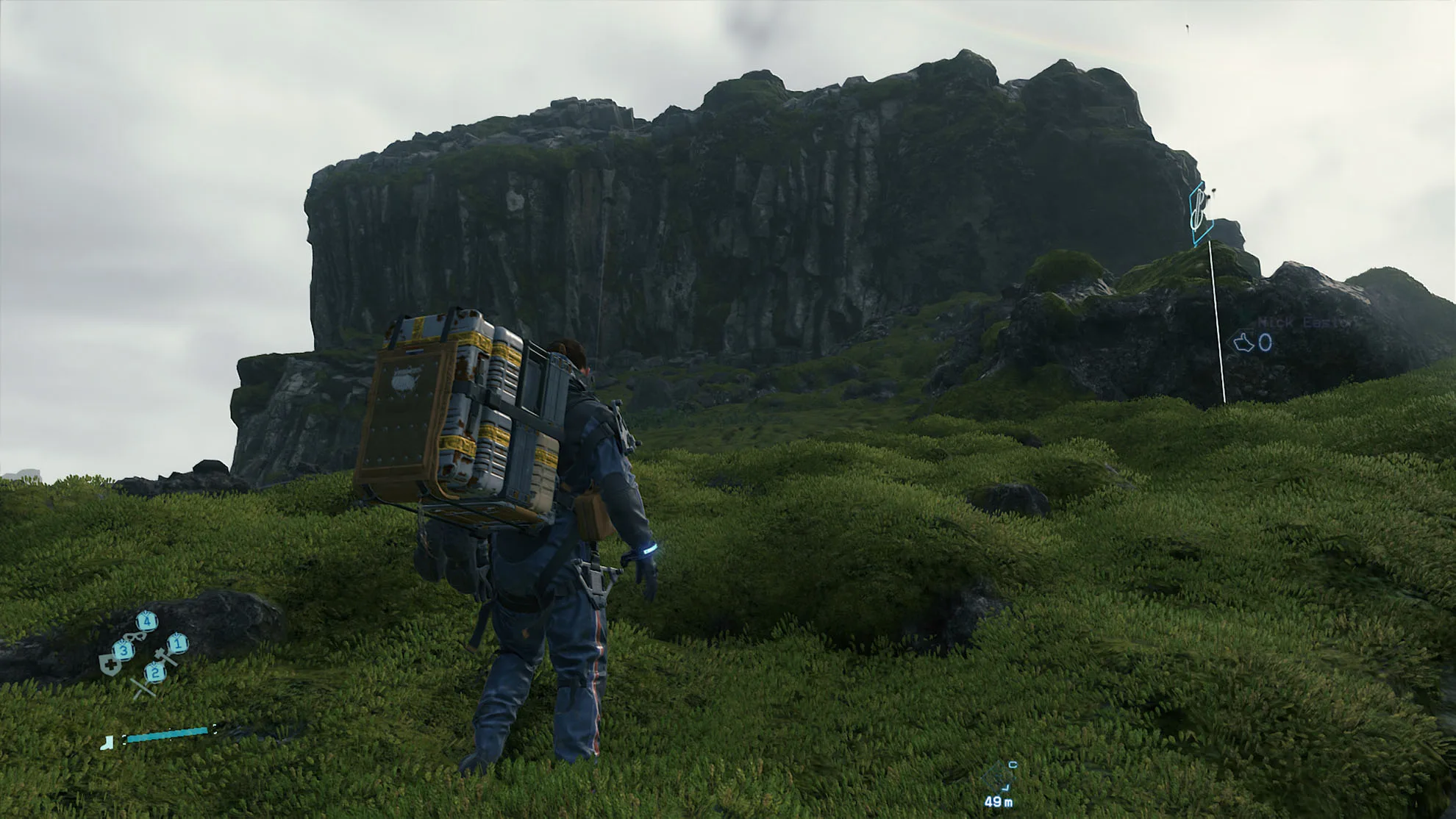
Before each delivery mission, you will strap a huge pack of supplies to your back, carefully balancing your load by continually tweaking the mouse while keeping in mind that your cargo will also deteriorate if you take too long during a timefall event. Above all else, you must hold on to your load while actively hiding from multiple deadly and nearly invisible BT enemies. There are also supplies lost by other porters to pick up and deliver, and human enemy bandit MULE gangs to contend with.
The game’s promise of new gadgets, upgrades, vehicles, and even weapons to fight the enemy BTs and human NPCs were not enough to keep my interest, and I was longing for fast travel. Gamers who appreciate the story and who enjoy minutiae micro-management will probably love the game.
Death Stranding is a game about connecting and connections and it’s pertinent to our own worldwide pandemic situation. No doubt it will be very popular, and BTR will add it to our benching suite. But for us, the best part of Death Stranding is its implementation of DLSS 2.0 and the free performance boost it brings without impacting IQ negatively.
Performance Options
Death Stranding is a well-done PS4 port to DX12 using the Decima engine. The developers were limited to 30 FPS on the PS4 whereas the PC gives much higher resolution and graphics options together with much higher and thus fluid framerates up to 240 FPS. Unfortunately, cutscenes are limited to 60 FPS and several widescreen resolutions are unsupported.
Here are the graphics settings that we used and changed for benchmarking – DLSS 2.0 or TAA which can only be used by RTX video cards. All other settings are set to their highest level at a rendering resolution of 100%.
FidelityFX CAS is another option for all video cards to sharpen TAA or for use without it. We find that 25% sharpening is about the maximum value we can use before noticing visible artifacting.
We are going to compare image quality using no anti-aliasing, TAA, and Quality DLSS 2.0, as well as look at FidelityFX CAS and chart the performance of the five current NVIDIA GeForce RTX cards:
- RTX 2080 Ti
- RTX 2080 SUPER
- RTX 2070 SUPER
- RTX 2060 SUPER
- RTX 2060
DLSS 2.0
NVIDIA’s DLSS 2.0 creates sharper and higher resolution images with dedicated AI processors on GeForce RTX GPUs called Tensor Cores. The original DLSS 1.0 required more work on the part of the game developers and resulted in image quality approximately equal to TAA. DLSS 2.0 is an improved deep learning neural network that boosts frame rates while generating crisper game images with the performance headroom to maximize settings and increase output resolutions.
NVIDIA claims that DLSS 2.0 offers IQ comparable to native resolution while rendering only one quarter to one half of the pixels by employing new temporal feedback techniques. DLSS 1.0 required training the AI network for each new game whereas DLSS 2.0 trains using non-game-specific content that works across many games.
DLSS 2.0 generally offers RTX gamers three IQ modes: Quality, Balanced, Performance. These settings control a game’s internal rendering resolution with Performance DLSS enabling up to 4X super resolution. Death Stranding has implemented Performance DLSS 2.0, 1080p → 4K, and Quality 1440p → 4K.
In our opinion, Quality DLSS 2.0’s IQ looks noticeably better and its larger hit to the frame rate is worth it over using Performance DLSS 2.0. We would prefer to lower other settings before we drop DLSS 2.0 from Quality to Performance.
Death Standing’s final anti-aliasing option, FXAA, is a poor post-processing choice since it doesn’t address temporal anti-aliasing as well as TAA and its performance savings is negligible. We will next focus on IQ, DLSS 2.0 versus TAA.
DLSS 2.0 vs. TAA
First we want to see an image with maxed out settings but with no AA.
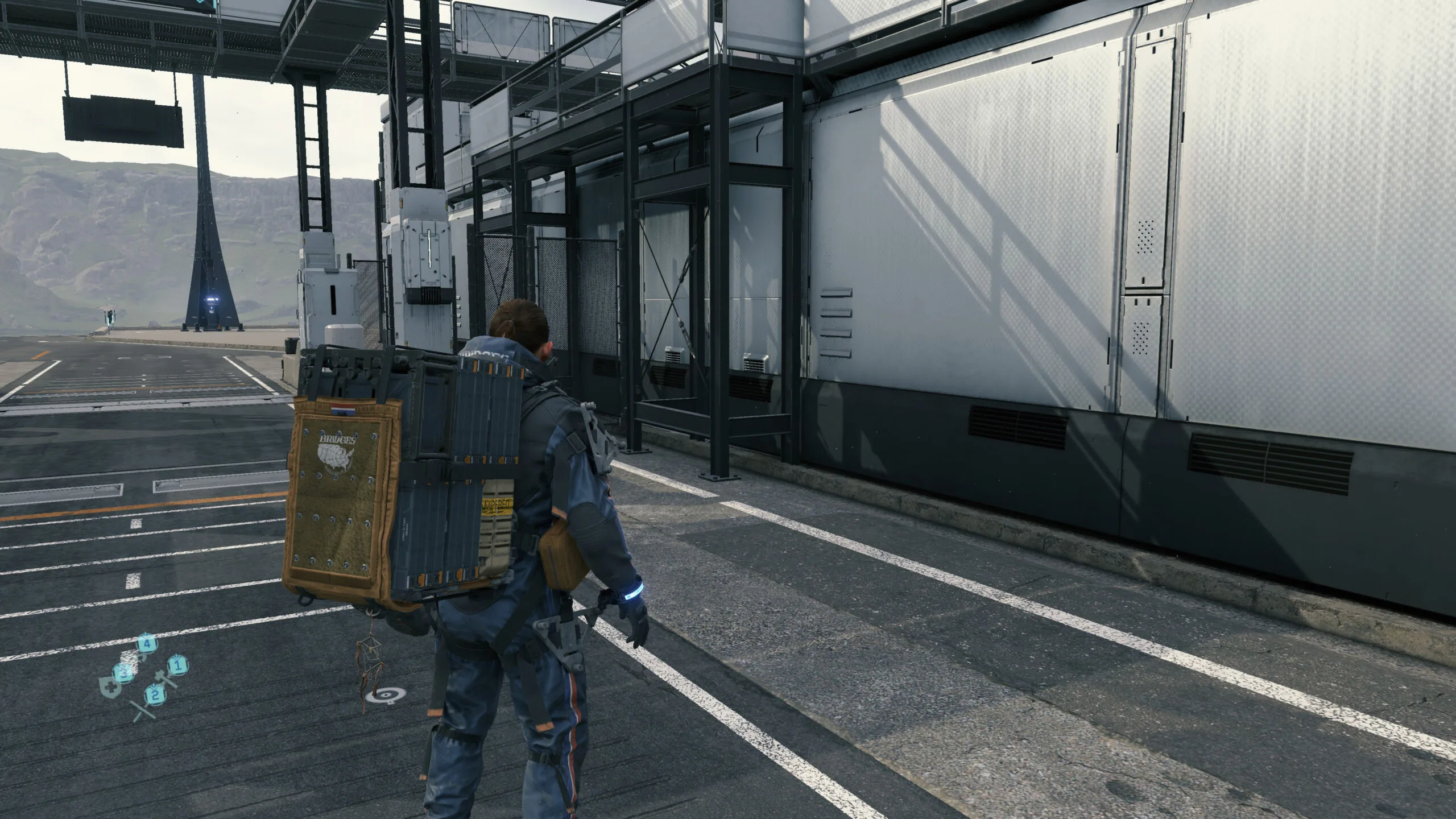
We don’t recommend playing without TAA or without DLSS 2.0. Even though still screen shots may be tolerable at 4K, the shimmering and crawling while the camera is in motion is very distracting. Using TAA only takes a very small performance hit. For example, a RTX 2080 SUPER will average almost 60 FPS at 4K highest settings with no AA, and it will only drop 2 FPS when TAA is turned on. TAA removes most of the shimmering and texture crawling, but it blurs the image.
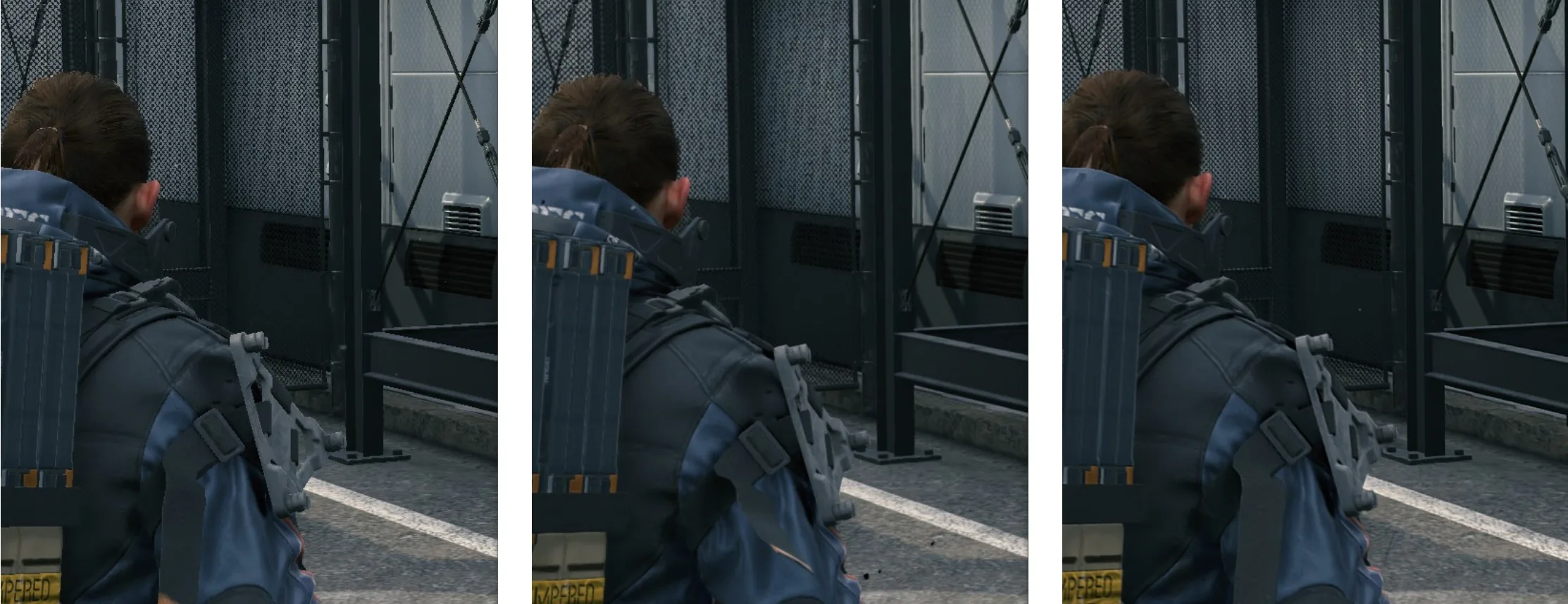
Above is no AA compared with TAA and with Quality DLSS 2.0. No AA is a jagged mess while TAA is blurred compared with the DLSS 2.0 image. DLSS 2.0 just blows away TAA IQ.
Here are some additional screenshots comparing TAA with DLSS 2.0. Please be aware that these scenes cannot be compared exactly because the scenes are dynamic and and constantly changing.
Here is the image without anti-aliasing.
Now we look at TAA versus DLSS 2.0.
[twenty20 img1=”18007″ img2=”17998″ offset=”0.5″ before=”TAA” after=”DLSS 2.0″]
The DLSS 2.0 image is sharper, and with the camera in motion, DLSS 2.0 gives much better image quality over TAA.
Here is an enlarged comparison of an area of the above image including adding FidelityFX CAS+TAA.

Above we see beginning left to right: (1) No AA compared with (2) No AA+Fidelty FX CAS then (3) TAA followed by (4) TAA+FidelityFX sharpening filter, and lastly (5) DLSS 2.0.
(1) The image without AA is very jagged, and adding (2) the FidelityFX sharpening filter + no AA only makes the jaggies look sharper. (3) TAA adds a lot of blur although it cleans up the edges, and (4) adding FidelityFX CAS at 25% introduces a few artifacts yet only sharpens parts of the image compared to the overall best image produced by (5) DLSS 2.0.
Performance
Yesterday, Death Stranding got updated to version 1.01 by a 5.1GB patch to address performance and bugs. We reran all of our benchmarks over again as performance has increased slightly. We use a very repeatable benchmark that takes place during a timefall (with rain & other effects) that is representative of the most demanding sections of the game.
Using Death Stranding’s highest settings we compare performance TAA versus Quality DLSS 2.0 of all five current current RTX cards at 1920×1080, 2560×1440, and 3840×2160.
DLSS 2.0 gains a large percentage of performance over using TAA, and it looks much better while doing it. We see a RTX 2070 SUPER playing Death Stranding decently with maximum settings at 4K(!) whereas before it struggled using TAA. Upscaled DLSS isn’t perfect, occasionally adding some artifacting, but overall it looks great with the camera in motion and much better than the blur that TAA adds.
Adding FidelityFX CAS to TAA still doesn’t match the image quality of DLSS 2.0, nevermind the performance it leaves unused. There is no reason for a RTX gamer not to use DLSS 2.0 for Death Stranding.
Conclusion
Death Stranding is an interesting game that may really appeal to many gamers. However, we are the most impressed by Death Stranding‘s visuals and the large free performance increase that DLSS 2.0 brings to it for RTX gamers.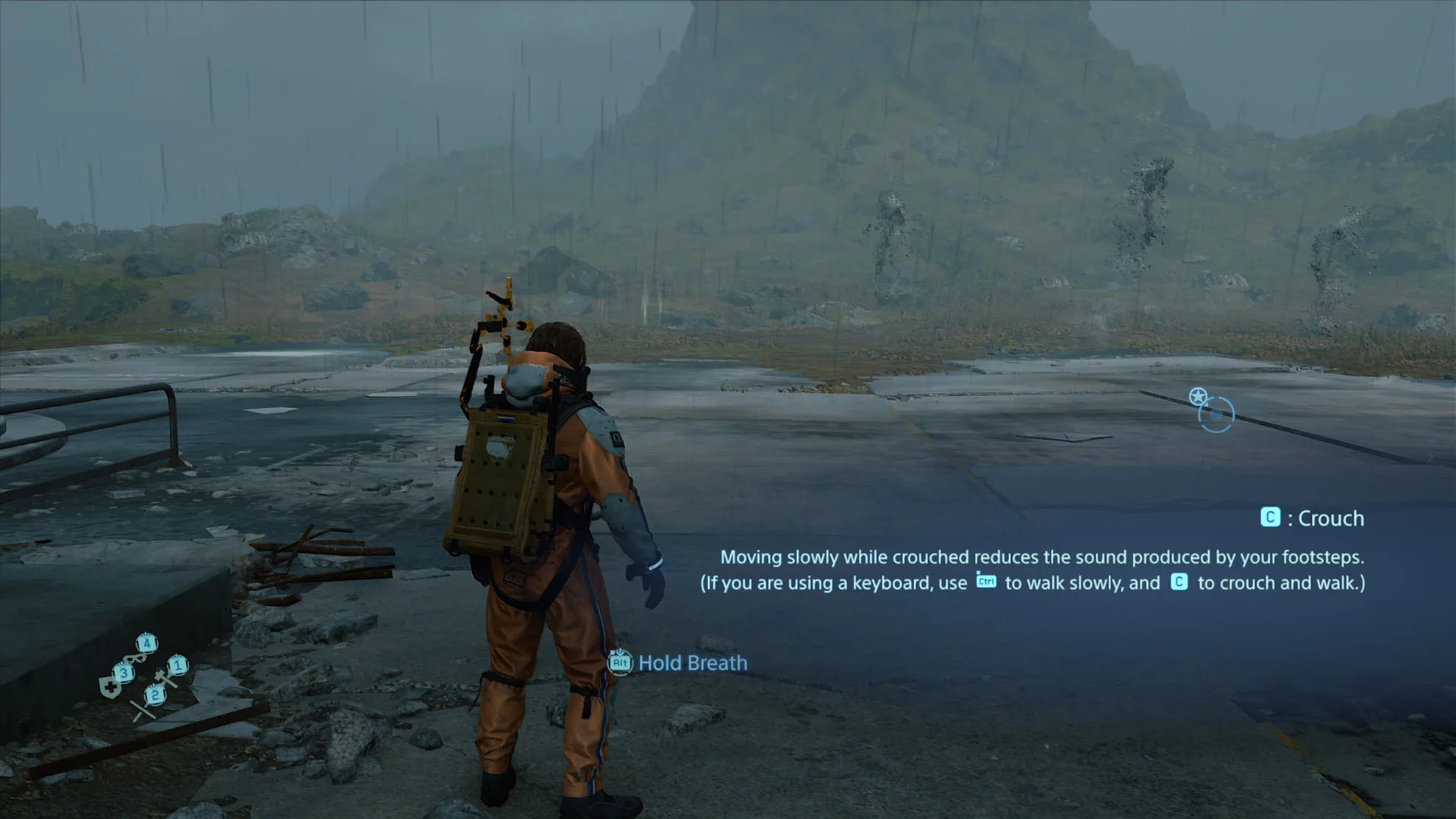
NVIDIA, 505 Games and KOJIMA PRODUCTIONS have recently announced the Death Stranding ‘Embark On Your Journey‘ bundle. Until July 29th, gamers will receive a Steam code for Death Stranding with the purchase of an eligible GeForce RTX 2080 Ti, 2080 SUPER, 2080, 2070 SUPER, 2070, 2060 SUPER or 2060 GPU-equipped graphics card. A list of participating retailers and etailers is available on GeForce.com.
We are heading immediately Into the Radius for a VR game and performance review for early next week. The game is based on the same ‘Roadside Picnic’ universe that S.T.A.L.K.E.R. is set in. After that, we will review the EVGA Z490 FTW motherboard to see just how high we can overclock our 9-10900K.
Happy Gaming!



